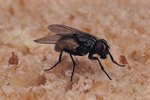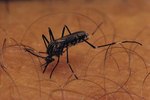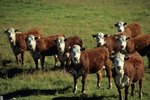
You don't have to be equine to fall victim to a horsefly, and anyone who's ever been bitten knows it's painful. Horseflies are pest insects found over most of the globe, but the designation horsefly is provisional -- the common name of this insect changes depending on where you go in the world.
Horsefly Distribution
Horseflies (Chrysops relictus) are found in most places around the globe, most notably Great Britain. To date, though, no record of this fly has been recorded in Iceland, Greenland or Hawaii. In the contiguous United States, the greatest concentration of horseflies is found in Florida. Florida provides ideal conditions for these flies with the abundant wetland acreage and regional spans of aquatic vegetation. Florida's temperate weather and reliable precipitation also make the state a suitable horsefly habitat.
Larval Development
Horsefly eggs are laid in batches of anywhere between 100 to a 1,000 individual larvae. Females prefer the underside of wetland foliage, protected rock ridges, hearty twig mounds and aquatic vegetation to lay their eggs. The egg disposition is usually on a vertically fixed object and preferably over water. Initially, the egg batch is an off-white color; it turns black as it develops and matures. Horsefly eggs are tubular and measure 0.04 to 0.10 inch in length. Depending upon ambient elemental conditions, in about a week the eggs hatch and the larvae will topple to the wet ground or water below. For most species, one generation per year occurs.
Nuisance & Threat Factor
Because not all flies bite, an entomological classification exists for biting flies, and horseflies are among the most common. While male horseflies feed on pollen and nectar, only females suck blood. The anatomical arrangement in the females' mouths forms a bladelike structure strong enough to break through tough animal hide. Other than being a painful nuisance, horseflies transmit diseases among farm animals and other exposed mammals; Anthrax was introduced in this manner. Incessant biting can result in gaping wounds and widespread infection. Just such conditions are often cause for an animal's stress, weight loss and erratic behavior changes. It is not uncommon for as many as 100 flies to feed at one time. Twenty to 30 horseflies feeding for six hours can extract roughly 3.5 ounces of blood.
Physical Distinctions
The horsefly is a Tabanidae familial species, of the genus Tabanus. Several subspecies fall under the specification of horsefly, many of which differ slightly in appearance. Physically, horseflies look nothing like their equestrian namesake, and the only apparent relationship is that these flies are often found around barns, stables and farm yards. Their antennae are segmented into three distinct parts, and their thoraxes and abdomens are cloaked in microscopic hairs. Horseflies have iridescent green or black eyes; their bodies are dark brown to black. Horseflies lack the apical spurs on their rear tibiae that are readily present on other fly species.
References
Photo Credits
-
Jupiterimages/Photos.com/Getty Images




